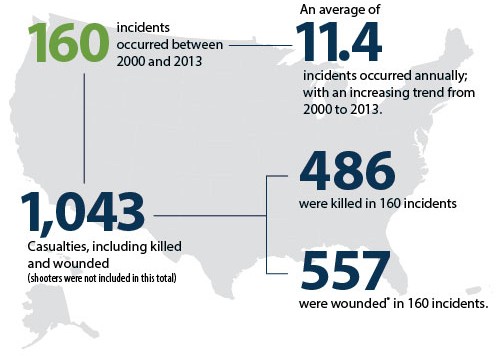Incidents Covers 2000-2013 Time Frame
The FBI has released a study of 160 active shooter incidents that occurred between 2000 and 2013 throughout the U.S. The primary purpose of the study? To provide our law enforcement partners—normally the first responders on the scene of these dangerous and fast-moving events—with data that will help them to better prepare for and respond to these incidents, saving more lives and keeping themselves safer in the process.
But we believe the information contained in this study can benefit anyone who could potentially be in an active shooter situation—like emergency personnel, employees of retail corporations and other businesses, educators and students, government and military personnel, members of the general public, etc.—by giving them a better understanding of how these incidents play out.
 We began the study in early 2014. With assistance from Texas State University’s Advanced Law Enforcement Rapid Response Training Center, we researched possible active shooter incidents in the U.S. during our selected time frame using official police records, after action reports, and shooting commission documents as well as FBI resources and open source information. We identified 160 events that fit our criteria—individuals actively engaged in killing or attempting to kill people in populated areas (excluding shootings related to gang or drug violence).
We began the study in early 2014. With assistance from Texas State University’s Advanced Law Enforcement Rapid Response Training Center, we researched possible active shooter incidents in the U.S. during our selected time frame using official police records, after action reports, and shooting commission documents as well as FBI resources and open source information. We identified 160 events that fit our criteria—individuals actively engaged in killing or attempting to kill people in populated areas (excluding shootings related to gang or drug violence).
Once the incidents were identified—and we’re confident that our research captured the vast majority of active shooter events falling within the specified time frame—we looked at each incident separately to identify its characteristics, then we correlated the data from all of the incidents to get a fuller picture of active shooter incidents in general. (See sidebar for highlights of the study’s overall findings.)
Because so many of these incidents unfold so rapidly, Special Agent Katherine Schweit—who heads the FBI’s Active Shooter Initiative—says she hopes the study “demonstrates the need not only for enhanced preparation on the part of law enforcement and other first responders, but also for civilians to be engaged in discussions and training on decisions they’d have to make in an active shooter situation.”
Using the results of this study, the Bureau’s behavioral analysis experts will now delve deeper into why these shooters did what they did in an effort to help strengthen prevention efforts around the country.
Today’s study is just one of the resources the FBI offers to its law enforcement partners and others to help coordinate and enhance the response to active shooter incidents. Other resources—due in part to last year’s Investigative Assistance for Violent Crimes Act and a federal multi-agency initiative targeting violent crime—include training for first responders, conferences for law enforcement executives, operational support in the event of an active shooter event, and assistance to victims. The Bureau is in a unique position to offer this type of assistance—we’ve played a large role in supporting the response to every major active shooter incident in recent years.
Major Findings from the FBI’s Active Shooter Incidents Study
The just-released “A Study of Active Shooter Incidents in the United States Between 2000 and 2013” contains a full list of the 160 incidents used in study, including those that occurred at Virginia Tech, Sandy Hook Elementary School, the U.S. Holocaust Memorial Museum, Fort Hood, the Aurora (Colorado) Cinemark Century 16 movie theater, the Sikh Temple of Wisconsin, and the Washington Navy Yard, as well as numerous other tragic shootings. Here are some of the study’s findings:
– Active shooter incidents are becoming more frequent—the first seven years of the study show an average of 6.4 incidents annually, while the last seven years show 16.4 incidents annually.
– These incidents resulted in a total of 1,043 casualties (486 killed, 557 wounded—excluding the shooters).
– All but six of the 160 incidents involved male shooters (and only two involved more than one shooter).
– More than half of the incidents—90 shootings—ended on the shooter’s initiative (i.e., suicide, fleeing), while 21 incidents ended after unarmed citizens successfully restrained the shooter.
– In 21 of the 45 incidents where law enforcement had to engage the shooter to end the threat, nine officers were killed and 28 were wounded.
– The largest percentage of incidents—45.6 percent—took place in a commercial environment (73 incidents), followed by 24.3 percent that took place in an educational environment (39 incidents). The remaining incidents occurred at the other location types specified in the study—open spaces, military and other government properties, residential properties, houses of worship, and health care facilities.


